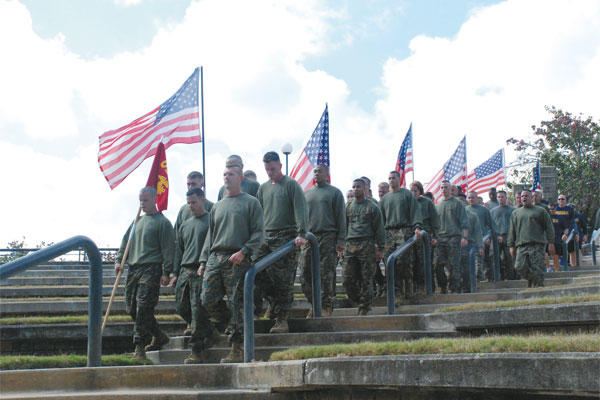Want to take a few years off from the military to go to school, start a family, or get business experience? If you're in the Marine Corps, this year could be your best chance to get started.
In a message quietly released earlier this month, the service removed participation limits on the career intermission program it launched in 2013, giving Marines the chance to take time off while retaining their career status and receiving a small stipend. While the original program limited participation to 20 enlisted Marines and 20 officers per year, the change means that all leathernecks who meet eligibility requirements and are approved by their chain of command can participate in the program.
The deal offered by the program is simple: Marines can take up to three years off in the Individual Ready Reserve to pursue personal plans and goals, and then re-enter the service with the same rank and promotion eligibility they had before. The only catch: Troops owe the service two years for every year of career intermission.
Marine Corps messages about the program note that Marines in job communities struggling to retain troops will be given special consideration, highlighting the career intermission program's usefulness as a tool to keep Marines who might otherwise leave the service altogether.
Navy Secretary Ray Mabus has championed that service's version of the program along with a slew of other initiatives, including increased maternity leave, to retain women, who leave the service at higher rates mid-career than their male counterparts -- many because of family demands. Mabus successfully lobbied Congress to remove participation limits on the Navy's career intermission program program in 2015.
"We were losing twice as many women from year six to year 12 than we were men," Mabus said in a 2016 speech in California, discussing the intermission program and his plan to increase maternity leave. "And if you want to look at it just from a purely selfish standpoint, the investment that we have in a pilot, submariner, surface officer or an intel cryptologist, an IT specialist, is huge. And if we lose that person after seven or eight years, we have to start over with somebody brand new without the experience. And we have to make that investment all over again."
But while the Navy's program has had modest success in participation, the Marine Corps program continues to struggle.
According to data provided to Military.com by Marine Corps Manpower and Reserve Affairs, the Corps has had only six participants in its four years of existence. No Marines participated in 2013, according to the data. In 2014, the biggest participation year, two staff sergeants and one captain took the intermission offer. And in 2015 and 2016, three Marines total participated, all captains. To date, only one woman has taken advantage of the program.
In the Navy, on the other hand, there have been 127 participants since the program began in 2009, Lt. Jessica Anderson, a spokesman for Naval Personnel Command, told Military.com. The demographics are fairly evenly divided: 58 of the participants have been male, and 69 female; 50 were officers and 77 enlisted, according to data Anderson provided. This year, 19 applicants were approved, she said.
The program has come under oversight scrutiny: In 2015, the Government Accountability Office published a report noting that all four Defense Department services had adopted the intermission program by 2014, with the Army the last to join, but only the Navy at that point had participants who had actually completed sabbaticals and returned to the force.
The report noted that military culture may be a factor inhibiting troops' participation, with anonymous troops reporting that members of their chain of command had warned them their careers would suffer if they took the intermission offer. For the Marine Corps, which has not come close to hitting the 40-troop limit on its program since it began, the removal of participation limits may signal a message of support from service leadership for those considering a career intermission.
The Navy continues to promote the program as an aid to keeping sailors in the service.
"We believe that CIP is an effective and flexible tool designed to enhance retention among those who might otherwise consider leaving the Navy," Anderson said.
-- Hope Hodge Seck can be reached at hope.seck@military.com. Follow her on Twitter at@HopeSeck.



























